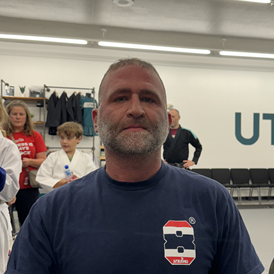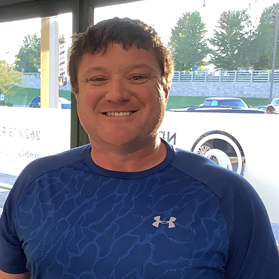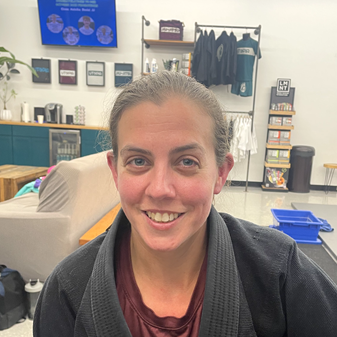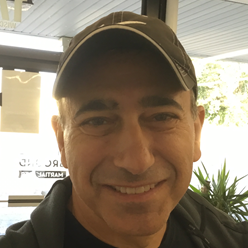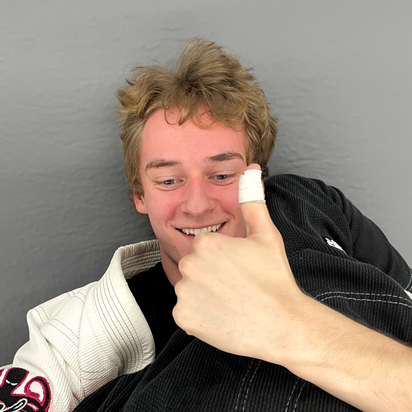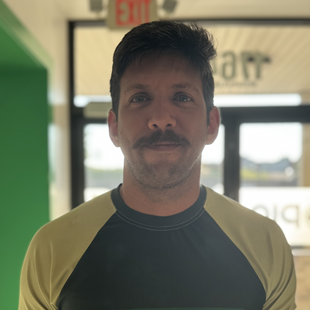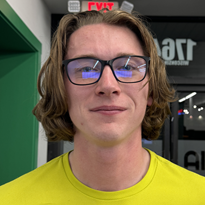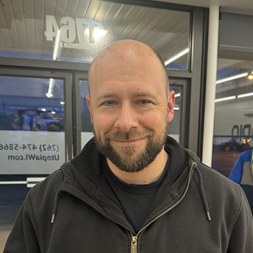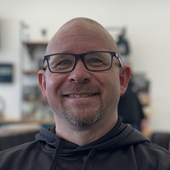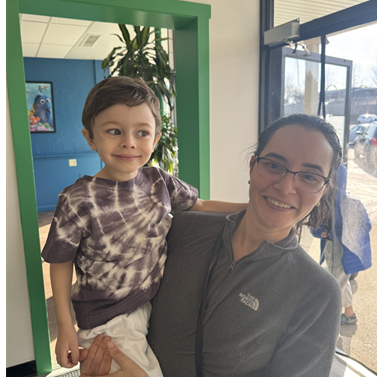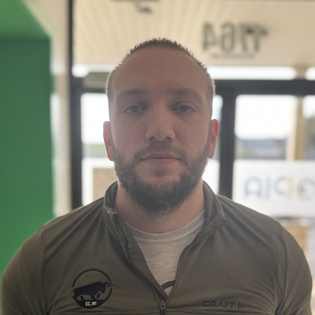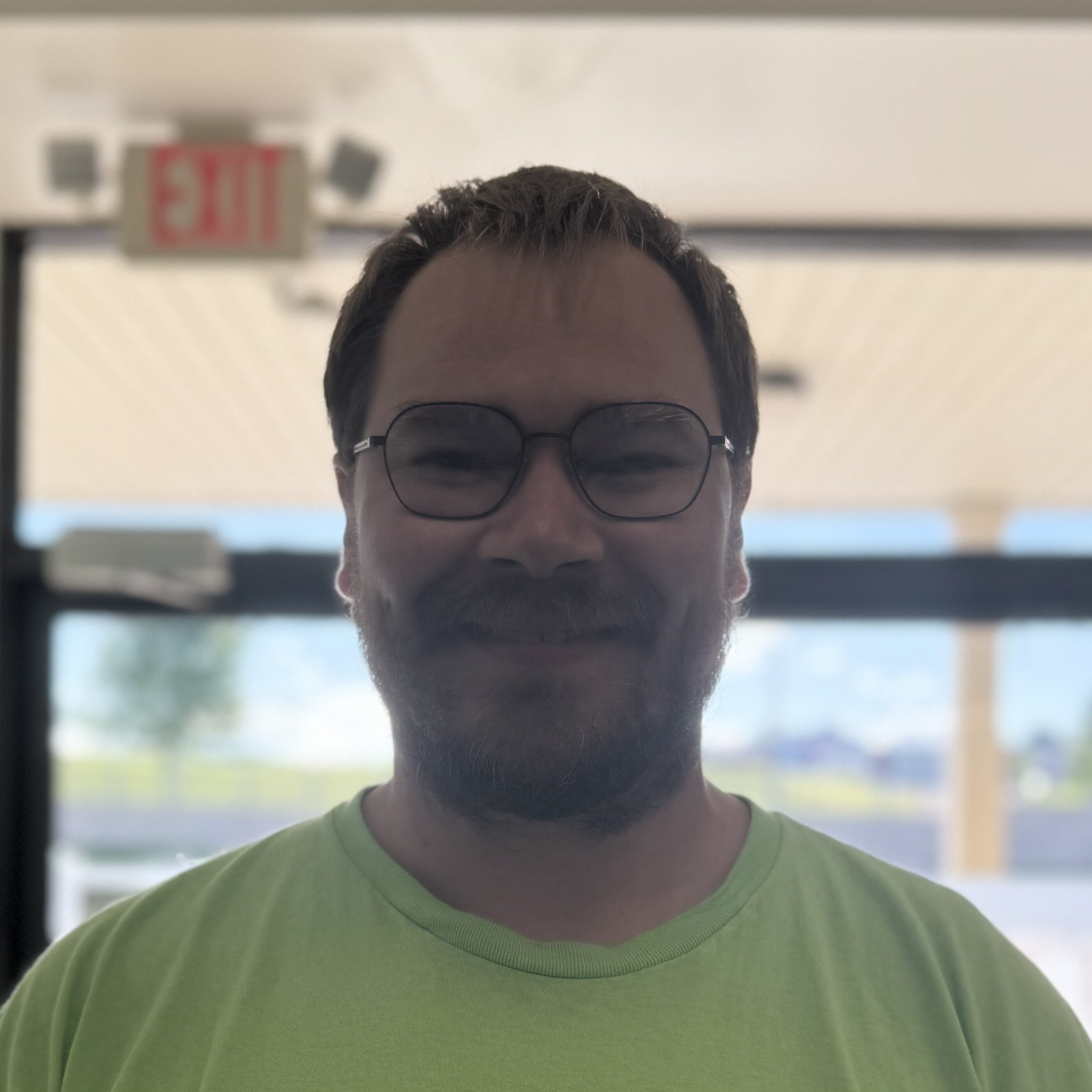As we age on the mats, our approach to training has to evolve-and that includes how we fuel our bodies.
In Episode 15 of Inside the Wave, Perry Wirth sits down with Kodi Volpano, a brown belt in Brazilian Jiu-Jitsu, nutrition coach, and creator of systems designed specifically for grapplers over 30.
Kodi’s experience spans not only the worlds of BJJ and strength training but also entrepreneurship, culinary arts, and building sustainable nutrition habits. Whether you’re a white belt just entering your 30s or a seasoned grappler looking to train smarter, this episode brings clarity, systems, and real-world tips to keep you rolling longer.
From Culinary Roots to Combat Sports
Kodi shares his unique journey from working in restaurants to diving deep into fitness and nutrition. His early exposure to the food industry laid the foundation for the meal prep systems he teaches today-practical, efficient, and tailored for active lifestyles. He opened a coffee shop, ran a meal prep business, and eventually brought his skills into the BJJ world. That background now fuels his passion for helping grapplers over 30 stay healthy without overcomplicating their routines.
Key Takeaways
- Nutrition for athletes over 30 isn’t about perfection-it’s about sustainability.
- Systems beat willpower. Build structure that adapts to real life.
- Prepping your meals is prepping your mindset.
- The right supplements support recovery, not replace effort.
- Your training longevity depends more on recovery than intensity.
Standout Quotes
“If your nutrition system isn’t sustainable, it’s not going to last-and neither will your progress.”
“Recovery isn’t a luxury. It’s a requirement if you want to train long-term.”
“We’re not trying to be perfect. We’re trying to be consistent.”
Where to Listen
🎧 Stream Episode 15 Now:
Connect with Kodi Volpano
- Instagram: kodakv1
- Resources: kodak_gummy – Free guides, nutrition systems, and tools for grapplers
About Utopia
At Utopia, we believe in personal growth through martial arts. Our community supports individuals of all ages, helping them challenge themselves, build resilience, and thrive both on and off the mats. Each episode of Inside the Wave aligns with our values of discipline, mentorship, and community, offering stories that inspire growth in every listener.
Why This Episode Matters and Why Nutrition Hits Different at 30+
Getting older changes everything-especially how your body processes food and recovers from hard rolls. Kodi breaks down what’s really essential when you’re past your 20s:
- Systems over tracking: Instead of obsessing over calories, he encourages building consistent habits you can actually stick to.
- Prepping like an athlete: Meal prep doesn’t have to be rigid. Kodi shares ways to make it flexible and sustainable.
- Digestibility matters: Choosing foods your body can absorb well is more important than simply choosing what’s “healthy.”
Join the Conversation
If you’re 30+, juggling training, life, and recovery-this one’s for you. Kodi Volpano breaks down nutrition and wellness in a way that’s actually doable for the everyday grappler. Tune in for simple, sustainable strategies that meet you where you are-on and off the mats.
Transcript
Perry: I need some water. All right, welcome to the next episode of Inside the Wave. I’m Perry Wirth. I’m the host, owner of Utopia Martial Arts. Today I have with me a training partner of sorts, another guy in the jiu-jitsu community, Cody, who is a brown belt. I think I first met you, Maybe I met you a really long time ago. Did I meet you a really, really long time ago? I don’t remember. But I know Open Mat was like my brain starts to click in a little bit. Yeah, yeah, yeah. I remember we had a role at Open Mat. And I think you were just coming off a neck injury.
Kodi: Yeah, it was like disc herniation and more lower back stuff.
Perry: Yeah, and we had a good role. And I think we rolled a couple of times. And then we had another Open Mat that we met. Started following you on Instagram. I’m like, wow, this guy’s doing some pretty cool shit, making cool content. creating coffee blends, talking about supplementation, putting stuff together. So I figured you’d be an awesome person to have on the podcast. It’s an honor. Cool. And I think the real benefit that the listeners are going to get today, I’ve really noticed in your content you focus on nutrition, especially for the 30 plus athlete. And I know you’ve also been producing content for female grapplers as well. So let’s just get right into it. So what is it? What is your background? What kind of, you know, what helps you stand out in this 30 plus community sports, nutrition, recovery, athlete area?
Kodi: One, I’ve been training jiu-jitsu for a pretty long time. I think right before we started, it was like I started in 2004. In jiu-jitsu.
Perry: Yeah. That’s like five years after like, what was it? Not 99.
Kodi: Did you just feel like just starting getting started in the Mecca, I guess is what I think about, but I think just having that experience and being a brown belt helps kind of understand and break down technique, but then also relate it back to nutrition.
Perry: Yeah.
Kodi: Um, and even just like exercise in general, but my background is exercise science and sports nutrition. And that was pretty much my journey all the way through. But prior to that, which is kind of where the coffee came into play. I come from a culinary background too. So I wanted to kind of blend all those things and just share it with the community. Where’s your culinary background come from? WCTC.
Perry: Okay. So right out of associates in culinary.
Kodi: No, I was on like the four year track. So I finished up like the initial culinary program, which kind of blended in with garbage and baking. So like cold kitchen and baking. And then I had this epiphany and I’m like, I don’t know if I want to do this for the rest of my life. My whole family’s in the restaurant industry. I’m like, I don’t know if I want to do this. So that’s when I transitioned more to like health and fitness and then kind of followed that trajectory. Very cool And you used to have a coffee shop for about three years. Yeah, and I’m so bad with timelines within that I think 2016 or 2017 We opened up and it was in the middle of nowhere. It was Eagle, Wisconsin and kind of like a thousand people Yeah, but the cool thing is I set outside kind of that location and started clicking traffic on the highway, like 67 and 83. And I’m like, there’s a shitload of cars coming through here.
Perry: I mean, man, the spirit of an entrepreneur, man. Big companies pay for traffic studies. When a big new grocery store might be built on a corner, the city does a huge traffic study where they lay out those strips that people drive over. And you’re just sitting out there with a clicker being like, how many people are driving past this?
Kodi: And I forget how long I stayed out there for, but my wife was like, what are you doing? I’m like, I’m just taking like AM, PM, and then just like figuring out that. And I can’t remember the exact number nowadays now, but it was a pretty big chunk. And I’m like, I think this might work, but it’s also hard to make money by just selling like $2 cups of coffee. So because the culinary thing kind of makes it, I’m like, well, we can do some like scratch made food and I can teach anybody to do it. It doesn’t have to be complicated. Kind of like nutrition and like jiu-jitsu, we can keep it simple. But that was kind of the start of it and I realized Also, there were three main corporations around us zero zone. Okay standard process and Generac, yeah, and we developed relationships all three of them and did catering events with them consistently That’s awesome. And then just developing that relationship. We had like we had a wedding there We had some like paint parties women nights out. Wow, that’s awesome a bunch of pretty cool things. I never expected to ever Like happened to me inside the coffee business nice the upstairs then like the spirit of the entrepreneur like you were saying I was trying to figure out how to maximize real estate because I spent about 10 years in retail sales Yeah, and I had a manager that said to me every single piece of shelving is worth something He’s like people pay a lot of money for this shelf right here. Yeah, but what about that bottom shelf? He’s like it could accentuate You know what this other thing does. And I’m like, wow, so that’s worth a lot of money. So what do I need to do to like maximize this upstairs, which was our shipping receiving and kitchen. So then that’s when I started kind of a lifestyle brand for Wisconsin and sold it all over the nation. That’s awesome. And that’s like how the coffee and the design work kind of came into place. And I was saying, I taught myself graphic design. It was all from that time. Yeah. YouTube university.
Perry: Man, you’re like a Renaissance man. Just jack of all trades. Like you could beat people up. You’ve started business. You’re an artist. You’re a coffee brewer, sports nutritionist. Like, man. Like, hobbyist at all levels. It’s just like, just enjoying the time. My wife jokes, we have a really good friend that’s a tinkerer. So my wife’s a real estate agent and helped a couple that we know find a house. And they’re like, the requirement was, the husband needed stuff to tinker on. Cause like always needs to be like just doing something, right? Like, are you a tinker? Like, do you like dabbling in stuff and trying out new things?
Kodi: I would say yes. Um, I’m also a gaming nerd. So like looking back to like my early years, I would just like start characters and games and like try to maximum. What kind of gaming nerd are we talking about here? So like MMORPGs, FPSs, um, I never got much into like magic. What were like your big games that you played? So for a long time was a game called Ultima online. Okay, and then Wow, of course was a big one Dark Age of Camelot like all those like nerdy PC games Yeah, I spent like I think ten years of my life on you. Oh Ultima online. Okay, and that’s when that guy The tinkerer side of things actually started making money on you. Oh when I was like 12, it’s crazy And my mom’s like, why are you wanting to set up a PayPal? And I’m like, mom, I’m like buying selling currency. And she’s like, what are you doing? I’m day trading. Yeah, exactly. Right. I’m making money virtual world and then people are buying it from us. And she’s like, how are you getting a hundred bucks? And I’m like, I try to show her and she, yeah, no, but that was like the MMORPG world where I would just dedicate tons of hours into that life. And, but I realized at that point though, I had to like create new characters. I was getting bored and my brain was moving. It was just.
Perry: Snap. And dude, I, I tell people all the time, like business and jiu-jitsu, it’s literally like playing a video game like that, where it’s like, you’re leveling up, you get new skills, you level up, you get new skills, you level up, you get new skills. Right. Um, you know, and I’ll, I’ll do even more common game, like Pokemon, right? Like Like just because A beats C doesn’t mean it’s not going to turn around the other way. Might be a special element. Yeah. Yeah. And it’s even like in jiu-jitsu, it’s like the power bar fills up, right? Like you have this power that builds up throughout your match. And if you exert all your energy, then you have no energy for the rest of the match, right?
Kodi: Yeah, I think kind of Gracie kind of was giving, I think it’s the first time I heard somebody say that he’s like, everyone’s energy bar is like up here and you have to like slowly gas somebody out. And then what if you don’t give as much energy, you’re eventually going to win that when that exchange. I think Hunter was the first person I kind of heard say that, but you obviously.
Perry: I mean, I was just talking to my students last night. Like I try to do a little match head at the end of every night, not like the jiu-jitsu, I’m your gospel sort of a thing, but like, you know, just something that came to my mind that helped me in my jiu-jitsu journey. And my message last night was like, Hey, like you strong guys, like use your strength. But if you’re lifting a 45-pound barbell, don’t lift it like it’s 300 pounds, because you’re just going to burn your energy on it, right? Use as much strength that’s needed in that situation to win. And if you use too much, you’re not going to have enough strength for the next situation.
Kodi: We had this. And this was at Open Guard when I was teaching. So he probably had to have been about 6′ 5″, 6′ 6″, 6′ 7″, and maybe 250 to 270. Really nice guy too. And ultimately he was wanting to train just to write, develop better skill sets, law enforcement agent. And he said he didn’t want to use too much strength. I’m like, well, if that’s your main asset, I’m like, you got to use it, but just be aware that you’re going to have a finite level of energy. So I always play this game like with certain people, whereas I would put him on his back and I would say, all I want you to do is get away. You couldn’t do it. And I said, perfect, let’s switch around the roles. I want you to hold me and mount. Couldn’t do it. And that’s when the light bulb goes off. It’s like, shit, this is a superpower. And that’s what I realized in 2004, because I came from a martial arts background. But then I was boxing at the time. And then I ended up meeting Mark. I don’t know if I met Sonia, who owned Twisted Fitness now. But that’s where I first started training. But prior to that, I met somebody else. I just realized that jiu-jitsu was such a superpower. But in that exact moment with that really big individual, I’m like, he only had so much energy. And once it was there, gone. And you can take the soul. You can sap the life out of somebody.
Perry: And that’s one of those turning points for those really big people. They go against someone like you who’s smaller. We’re kind of the same size. Not that I’m small, but on the mat, I’m much smaller than a lot of people. But they go against someone like you and you do that and their path goes one of two ways, right? What the hell did that guy just do? What is that magic? I want to learn it. I weigh way more. I should be able to do that. I want to learn. Or it’s like they get scared and they start veering away from the path of jiu-jitsu.
Kodi: Yeah. It could be more of the ego side of things, maybe a combination of it. I don’t know if he still trains, but really nice guy and really good training partner. But once they learn, six months down the road, it’s like, whoo. Terrifying you’re like look in the room. You’re like mmm. It’s terrifying. Yep. You’re like I’m not sure if I want to Do this today, but we all right slap.
Perry: Oh, yeah. Yeah. Yeah. Yeah, like I’m gonna regret teaching you this technique Yep, cuz it’s not gonna be fun for like like Marcelo said it’s like the big Kimura like
Kodi: Yeah arm triangle type of stuff and it’s just like this is not good. Yeah, I hate you did too.
Perry: Yeah for sure So what are like you’re you have a lot going on what are your like top two three focuses in your life right now I
Kodi: So right now I would say is more just learning more about women’s health.
Perry: Um, especially in the grappling world, always kind of insane topic, like being, and I’m going to say this like straight up, like being a guy, you can’t just apply like male nutrition to females. And a lot of people do that. And I think a lot of people just view nutrition as nutrition and it is very different. Like there’s like core things, but. There’s a lot of other things you need to take into consideration with females.
Kodi: Yeah. And I come from that nutrition slash like exercise background and I felt like I was doing my like clients a disservice. I’m kind of reflecting back that I didn’t understand more about like the differences. Yeah. But also I’ve been taking a lot more classes, doing a lot more continuing education and then also reading a lot more with like Dr. Stacey Sims. And she says women are not like tiny men or maybe I’m paraphrasing inaccurately. And again, still not in full comprehension, but another big driver is my wife who also trains and competes in jiu-jitsu. I’m like, I just want to like make this better.
Perry: You can understand more. Support her, understand her. Yeah, that’s cool. And give her props. She’s a leader in the women’s jiu-jitsu community, greatly involved, I see, in all those open mats and stuff like that. Massive influencer. That’s awesome.
Kodi: Yeah, really fortunate to be part of the team, or part of her team in the jiu-jitsu world, but also her husband.
Perry: Yeah, very cool. Um, so yeah, I know women’s health and then you do a lot of, uh, like your other focuses males over 30, uh, which is a, you know, owning a gym, at least a gym in a suburb, I should say, right. Gyms in Milwaukee might be a little bit different demographics. Like that is the average person coming into our adult coming into our gym. And I would say. 30 as time goes on, but like, man, it’s even like, you know, we get a lot of 40 year olds and some 50 year olds. And we just had a 60 year old woman just started with us and dude, she’s fucking bad ass. She’s bad ass. Like all of her family, like all of her sons, Russell and shit like that. She, she has like a,
Kodi: Franchises a haircut studio with like 13 locations just got into it after insurance like just yeah and like to even have the I Don’t know that in the instinct or like inclination of just stepping into a jiu-jitsu area like by herself Yeah, and that she trains with her family and stuff. But like Yeah, I mean, it’s pretty amazing.
Perry: Yeah Coming in and especially coming into a male-dominated sport like we have females at our gym and But like, not a lot, you know, it’s so hard to build a women’s program. And we really try to do our best and be inclusive, right. And we get a ton of feedback, like, she praises how good our team is and our instructors. But, you know, even though the males are incredibly helpful, incredibly kind, it is just a different energy when there’s not more females there.
Kodi: To circle back to like the 30 plus side of things. Um, I just realized that more people were asking me questions and I was having more conversations with those athletes, probably because it’s the main demographic and I’m not 18. I’m not a 20 some real world champions. So. my demographic and the person who’s going to ask me questions is going to be the dad, or it’s going to be the more casual competitor. And right now I’m maybe training three or four days a week, but for the most part, I would say it’s pretty full time, including like strength training and like other things too. That was like majority of my conversations. And I realized that just like them, time is really the problem. And you can give somebody a diet and shit. I mean, you can ask Chachi BD to do anything. You can go to Claude, Gemini, and I’ll use all those tools. They give you the recipe.
Perry: Yeah.
Kodi: But it’s like, how do you piece this in to your life? And that’s where like, I’ve done these things and I’ve like R and D did, I guess, but circling back to culinary school, especially for the 30 plus athlete, I was taught systems and those systems and cooking were never taught to like most people. So I started asking a bunch of, um, just random conversation, like random people who I was having conversations with. And I’m like, who taught you how to cook?
Perry: Yeah.
Kodi: Mom, dad, YouTube. I just figured it out.
Perry: I worked in a restaurant in high school.
Kodi: Worked in a restaurant. Maybe you were a line cook. Maybe you did prep. But usually dishwasher was the starting point. That’s where I started. Me too. But you were taught some sort of systematic operation. Cooking was the same way. But for the most part, people didn’t really have a system. So my brain started to kind of systemize. And the 30-plus person was the one who would listen. And they would say, whoa, you’re using Cambros? And I’m like, yep. I had Cambros for my business, and I love Cambro. But it’s nice to have that stackability.
Perry: I’m trying to get away from plastics. I know. It’s an interesting dichotomy. But we also, I am a huge Cambro user. I’ve been doing that cucumber trend. You ever see the cucumber trend, where it’s like, You literally just take a seedless cucumber and mandolin the entire cucumber, and then mix in some stuff. You could do Greek yogurt and smoked salmon. Or I did a spicy chicken one. It is really good, but it’s kind of just like a salad with cucumber. And I’m going to pick your brain on this. I’m the worst at eating vegetables. I guess cucumber’s not even a vegetable, is it? It’s technically a fruit. But it’s green, so I’m going to count it. It’s like tomato. It’s a fruit. I was literally eating my plate of food the other day, and I went to my wife, I was bragging, I was like, look at all these vegetables I’m eating. And she’s like, those are all actually fruits. I’m like, fuck you. I’m like, fine, but it’s better than just meat. Yeah.
Kodi: Um, I forgot what I was saying, but systems Cambros. Yeah. So the plastic side of things too, like I do get, that’s like most of my conversations pretty much every day or like trying to limit exposure to, you know, a bunch of things, whether it’s EMFs, microplastics and macroplastics, if you’re just chewing on literal plastic stuff. But, you know, life is so hard, and especially when you’re training, you have family. Plastics make things easy, and they don’t break. And arguably speaking, I had a client in the past who used all Pyrex. And then the top of it, though, is plastic. And I kind of said, I’m like, I’m glad you’re using plastic, or I’m glad you’re using Pyrex, but you’re still having plastic exposure some way, shape and form. That’s covering it. Yeah, it’s kind of a horse a piece. I’m like, well, the only way to really do it is like just cook meals fresh consistently.
Perry: And like, did your food come wrapped in plastic? Did you put it in a plastic vegetable bag?
Kodi: You rubbed my mind. You rubbed my mind. It’s already contaminated. Yeah. And you’re going to a grocery store. You’re not growing your own food. For sure. And so that’s where it’s already so complex. And you’re already complicating the process. So if you can develop a good structure and then optimize and then lock in or like dial in your process, sign me up.
Perry: Yeah.
Kodi: But that’s kind of what I spend most of my time having conversations around more of the psychology behind food prep or like systemizing your life. Yeah. And the 18 year old typically will not be at that time in their life to like say, yep, I’m ready for it.
Perry: And I, man, I was 18 once and it was a long time ago, but I feel like you just don’t notice it as much when you’re 18, right? Like, you know, just like the bumps and bruises on the mat when you’re young, like you recover fast. Like you don’t, you don’t remember that arm bar that got slapped on you like five days later, right? But same thing for food, right? Go, go pound a whole pizza, right? You feel good the next morning, right? Like, I feel like as I get older, it affects me a little bit longer. Definitely. So I think we kind of need to be more keen to that. So what is your, I mean, I wasn’t even planning on going into this on the podcast, but I love this, because I am a very systematic person. I am the person that I could literally eat the same meal, and I do eat the same meal every fucking day. And my wife laughs at me for it. Like, I’ll find something new, and she’s like, how long are you going to do this for? I’m like, ever. Until I get sick of it, which is usually months. which is usually months. I went through a Ninja Creamy stage last summer where I did Ninja Creamy in the morning. Just let it drop? Yeah. I just did a bunch of fruit in it and some protein, and it was great. I was getting fiber, and some carbs, and vegetables in it, and protein in it. It was a really great breakfast. And then it started getting cold, and I moved on to eggs and cottage cheese. And then I did some overnight oats for a while. But I’m not like a Monday and Tuesday and Wednesdays meals are different. It’s like I eat the same thing for a month. So that’s how I work. But how do you go about creating a system? Or can you tell me a sample one?
Kodi: So I like acronyms. And I don’t know how this came to my mind, but it’s like landscaping and sod. And you lay sod to that area, and it grows nice and flush and flourishes. The acronym is SOD. So structure optimization and dial in. So most of the athletes that I’ll talk to, or even like work with, it’ll be based in the structure phase. So what that will look like is consistency. I really want them to have 10 to 15 different like core foods. It won’t necessarily mean that they have to do that forever, even though if it’s someone like you, you can do it for months. I take that like Seth for Rosie or Seth for Ross. I forgot how his last name is approached chicken and rice.
Perry: Yeah.
Kodi: And then I’m going to ask that question in the intake and say, what can you live on forever? Like, let’s say that you love Puerto Rican food. Yeah. What are you going to do? That’s going to be just this and let’s keep it in your meal plan. That’s cool. Let’s not change it. Let’s give it time because one, if the stomach gets jacked up, we can’t train. We can’t think. We really can’t even operate. But if you keep on diversifying and changing stuff up, we won’t be able to put that into the chemical equation, which is your body. and then get feedback out and we can’t then lock in. So I find that a lot of people will say, well, I get kind of bored of this, kind of a hard ass. I’m like, well, you told me 10 or 15 different foods that you like. We’re going to stick to that. There’s not very many substitutions. Not yet. Let’s give it some time. Now that could be maybe four weeks down the road, five weeks down the road, but I think if we’re really being honest with ourselves, how many people, either listening or watching this, have actually stuck to something for one week? I’m going to say not very many because I’m victim to it as well. Like yesterday, I forgot what I had. Oh, I had barbecue yesterday. I don’t have barbecue. I don’t. But I think we went to Smoke Shack. We were in Milwaukee. And I’m like, you know what? Let’s get wild.
Perry: Shit happens. But it wasn’t a whole week. Yeah. Life has things that pop up. So much of what you do, like psychology comes into it, right? And you were talking about psychology before, but you know, some people have like on and off. Right. And, and I struggle with that. It’s either like, I am all on and if I fall off, like I’m off. Yep. Right. So, um, but I, I’ve gotten way better at allowing myself to do that because Like to me, it’s like, why does it matter? Right? Like, why do I, why does my diet need to be all locked in all of the time? And why do I need to let it bother me if I go off for one meal? So getting okay with, you know, going to a social event and eating whatever foods there is something that I’ve, I’ve had a challenge to get, to become okay with.
Kodi: Yeah. The, um, so I think we both listen and consume this person’s content, but Mike Israel.
Perry: Yeah.
Kodi: He’ll talk about kind of a 10 week deficit or a 12 week deficit being kind of like the max. I followed our piece, um, program for a while. And like, that’s kind of where it gets a little intense, right? Like when you’re really like limiting certain things for 10 weeks, we got to come to a maintenance. But what I realized, and this is just more observational, that athletes will follow a four-on-two-off approach, meaning that they’ll do four days perfect. Monday’s perfect, Tuesday’s perfect, Wednesday, and then Thursday. And then all of a sudden, Friday comes along, and they’re like, you know what? I’m going to have a drink. I’m going to go out. I’ll do a ranch water. I’ll do a cut water. But then they’ll add other things to it. And sure enough, they actually just increase their total caloric number. And they canceled out their deficit Monday through Thursday.
Perry: Yeah.
Kodi: Saturday comes along. You know what? I’m going to do a little bit better this day, but they’re still not going to be in a surplus. And then Sunday, they get back, and they message me, or I talk to somebody, and they say, yeah, I kind of went off the bandwagon a little bit. But if you can just limit one of those days then. So let’s say it’s a four on, two off that I observe most people do. If you can do a five on, That’s dramatic difference. Yeah. Then you can give yourself forgiveness on that next day to say, you know what, if I do the burger, it’s okay. But again, it’s so hard to get things so aligned that a whole week that you’re just following a plan.
Perry: What is, what is your like, uh, when working with a client, what, what are your priorities? You know, I, I picture like these pyramids that some people have where it’s like calories on the bottom and supplements on the top. But what I hear from you, it’s not even. like calories at the bottom, right? It seems like it’s more like the systems that you’re following and even a bigger picture than just caloric intake.
Kodi: Yeah. And what, so if we rewind a little bit to like, when I first started writing plans, I was like directly out of school, you know, and I guess it’s kind of like when you’re a blue belt. Yeah. I think, you know, everything you’re like, so focused, you have this like triangle, especially backwards, especially when we were blue belts.
Perry: Yes, sir. Oh, like we were, we like literally gods. God’s like the highest rank on the mat.
Kodi: So actually in the room, you didn’t know everything and you’re just ragdolling people until somebody comes in with a wrestling background and they’re like, yeah, I’m gonna show you. Yeah. Yeah. But worlds have changed. All right.
Perry: Um, so I forgot what I was saying at that point. Uh, like, What is the, what is like your base level of now?
Kodi: Oh yeah. So more of a nations. Yeah. So more of like the system set up of things too. It’s like, I thought I knew everything at that point. And I was writing programs. I was giving like a diet. I would charge, you know, a couple hundred bucks for whatever it was. And I would give it to somebody and they would fail, give it to somebody else. They would fail. And I was thinking, okay, what am I doing wrong? I’m giving them the right calories and I’m giving them the macros that I felt were appropriate. And you can find any plan you want online. It could be, you know, a 33% distribution, fat, carbs, and protein.
Perry: There’s like a million calculators.
null: 40, 40, 20.
Perry: I mean, there’s tons.
Kodi: I would give them what I thought would be appropriate based on what I learned in school, and they just weren’t following it. And I had this epiphany, and I’m like, okay, well, what is the rate limiter? What’s the common differentiator between or differential between all these individuals? Why am I giving them all the details, but none of them are succeeding? Yep. And now we have like AI, right? All the information’s there. And I realize, and this is just me personally, it’s because they didn’t have their life set up for prep. They didn’t have their systems in place. They didn’t make it easy. Exactly. And they also didn’t know how to do it. So now, as you mentioned, kind of my content, I’m giving everything for free. So whether it’s like, it’s like if somebody is watching or listening, like I’ll give them.
Perry: Do you have a video on how to cut like a dragon fruit?
Kodi: Exactly.
Perry: And I had dragon fruit in my fridge and I was like, uh, my wife bought them. I have no idea how to cut these things.
Kodi: Exactly.
Perry: I watched a video this morning. I had to cut a Kiwi.
Kodi: Yep. Yep. Pineapple, et cetera. I mean, all, all, all Jeremy’s laughing at me like, bro, you don’t know how to cut a Kiwi. Yeah. Well, and I think you actually commented too. Like when I did the Kiwi video, I use a peeler.
Perry: Yeah.
Kodi: And when I was first shown that I was like, Oh my God, this is amazing.
Perry: And I, God, I should’ve watched your video. Cause I was doing it with a knife again this morning. Um, I saw the spoon video, like we even spoon it out and I was like, I’m not going to do this. Like my spoon’s not sharp enough. Uh, Dan, I’ll peel it with a knife. And like, it took so much of the fruit off.
Kodi: Should use a peeler. I know. And then same thing, even like with pineapple too, you’re like shaving down the sides. I mean, everyone has their own system, but I thought it was more important to like figure out how each person individually did their life and learn how they operated. Then that’s kind of where I come into play is then breaking down what their life looked like. because I’ve worked with third shift athletes, second shift athletes, first shift athletes, and I’ve done all of that. So I’ve worked in all those different pockets, and I realized that I was prepping at each individual time differently.
Perry: Yeah.
Kodi: And it didn’t all rely on like Cambros. Right. But it’s something that I experienced and learned that I could help and share with other people.
Perry: Yeah.
Kodi: So, and that’s what the content that I’m creating and I have a lot of film that I haven’t edited, which again, you have an amazing operation here. So I love the professionalism of your podcast, but it’s like. I have a whole team behind the podcast. It’s a whole team of one that does a great job. I mean, the amount of hours it takes. So like without diving down that rabbit hole, I have hours of material that I’ve shot. It just having to. Yeah, get something final. Yeah, so feel you but it’s kind of based on that a little bit But the calories are important. And that’s actually another observation that most athletes just under eat. Yeah. So, but if we can give somebody enough calories, that’s the starting point, but then getting them to use it as different.
Perry: Well, to your point, they, they under eat most of the time. And then when they’re not under eating their way over eating. Right. So you’re never eating at right. It’s true. You’re, you’re never at like a jog. You’re either at like a walk or a dead sprint.
Kodi: Yeah, like a binge almost, and then you just send it. And that gets into like, again, that four on two off approach. I noticed most people kind of taking part in Yeah. Awesome.
Perry: Um, what, you know, for your, you know, 30 plus year old athlete, what are your top like nutrition tips or focuses in general, that you could give the general public without having to go into like a customized plan? Do you focus around the one gram of protein per pound of body weight thing? Things go in and out. Last year was that protein thing. This year, it’s like 35 grams of fiber. What is your kind of some baseline recommendations that the audience can take away?
Kodi: So my core pillar is eat what you can digest or eat what makes you feel good, at least just to start with. Um, have you ever heard of the name John Meadows by chance?
Perry: Like the Meadows row, like the exercise in Meadows row. Yep. That’s John Meadows, right? Yep.
Kodi: So he was, um, he was my coach when I was initially in the bodybuilding powerlifting world. And I’ve had a few different coaches and mentors, but he was so communicative and just really helpful. And he said, it’s not about what you can eat. It’s about what you can digest.
Perry: Okay.
Kodi: And then I started figuring out just because a food is good, doesn’t mean it’s good for you. So, especially as we age, whether it’s decreased stomach acid or the gut really isn’t doing what it’s supposed to, maybe you’re on different medications. There’s a lot of variances and traditionally that 30 plus year old athlete will be on some sort of medication. Hopefully not, but it’s statistically there could be proton pump inhibitors and that also messes up with stomach acid and digestion. So I first want to figure out kind of from that, like that initial conversation, what are they going to eat? So viewers and listeners can take away. If your food doesn’t agree with you, maybe change it out. Maybe chickpeas are amazing.
Perry: Yeah.
Kodi: Maybe, um, cauliflower is amazing. Maybe broccoli is amazing, but instead of doing the whole broccoli with stock, maybe just do the broccoli for a floret.
Perry: Yeah.
Kodi: Um, just like try some stuff and see if it reacts to your stomach meets the same way protein. I think it’s pretty much documented. Now we want a good amount of protein.
Perry: Yeah.
Kodi: I always try to say if we’re in a deficit, we can go up above a gram of protein per body pound. And that’s pretty documented.
Perry: Yeah.
Kodi: If we’re in a calorie surplus or you’re eating more than what you would normally need for your workload, we can get away with a little less protein because of then just becomes expensive fuel.
Perry: Yeah.
Kodi: Then I prioritize carbohydrates.
Perry: Yeah.
Kodi: So I would say some key takeaways are eat what makes you feel good and then ultimately eat enough food. And even for the masters athlete too. Yeah. Because a lot of times that masters athletes doing things nine to five family.
Perry: Oh yeah.
Kodi: And so they might not be getting their full meals in. If you need convenience, that’s totally fine. I prioritize whole food way over anything else. And I prioritize to eat your food versus to drink your food. But if we need to drink our food, we can. And then you kind of get into that like nutrient optimization stage, which is kind of different than structure, but still it’s going to give you calories.
Perry: Yeah.
Kodi: So those would be probably the two major things I would probably send to a listener or viewer is it makes you feel good to start and then kind of play around.
Perry: Um, like pre-workout post-workout meals. I know, um, you know, there’s whole concepts around like carb cycling around workout times and stuff like that. I’m sure you, you follow that, right. Try to push your carbs around your workout, but like, what is your. perfect pre-jiu-jitsu class meal? Not a competition team two-hour burner class, like a standard jiu-jitsu class. What are you trying to eat before and after?
Kodi: Yep. So most of the time, I focus around peri-workout nutrition. So no pun intended. And that’s actually a John Meadows concept, is all the nutrients that we’re looking for will definitely be around the workout time. Some sort of carbs, protein, electrolytes. If you throw supplements, we’re going to be around there, too. Um, that can include creatine and, you know, um, electrolytes, et cetera. But pre-workout wise, I kind of follow, um, a four hour, three hour, two hour and one hour window, like timing phase. So I always say that within four hours, three to four hours of the training session, that’s the last time that you really want to have like. an egg and potato meal. Something you have to kind of like chew and use like mandible activity. Then three or two hour window.
Perry: So you don’t want that sitting on your gut before someone knee on bellies you.
Kodi: Exactly. Well then all the blood flow is kind of going to the visceral versus going to the periphery where we need it to go and make attachments and kill people. Not actually kill people.
Perry: I use that phrase all the time.
Kodi: Impose our will. So then that three or two hour, I kind of want more like easily digestible nutrients. So what I typically do and what my wife does as well and sits really well with her stomach is. Um, just a smoothie that could be a little bit of nut butter, um, protein powder. I like egg protein at that time. And then it’ll give me a little bit more of a suspended, uh, sustained release versus whey protein, a little bit quicker acting and then blend it up with some like fruits and things that like we enjoy. But that would be like, usually the last meal that I typically recommend for most athletes. So it’s like an hour or two before training, like ish. Yeah. That all depends on how the stomach can handle it. Okay. Um, everyone’s so different, but I would say that that’s probably the last time. And then intro workout, I’ll typically find myself either having like a recommendation of electrolytes and amino acids.
Perry: Okay.
Kodi: If somebody needs carbohydrates, maybe it’s like a half of a banana, maybe like a half an hour, hour before. Boom. Yeah. And the milligrams could all depend too, depending on your climate too.
Perry: Sponsor me slowly trying to get elements. It’s going to happen someday.
Kodi: It will happen.
Perry: So intra-workout, electrolytes, aminos. Carbohydrates if it’s longer?
Kodi: Yeah, it could be. So what I say is this about carbs is that I find that I first just want, and this kind of comes back to the psychology of things. If I’m consistently running carbohydrates for an athlete every single time, it’s all depending on what their body can handle. And then I’ll maybe use a powder, or I typically avoid goo gels. And I avoid anything with a fructose content. A little bit harder on the gut. It depends on the person. Some people do gummy bears.
Perry: My wife loves sour patch. Yeah.
Kodi: Gummy bears. I’ve seen it. I mean, you know, I guess whatever, um, yeah, whatever fits yours.
Perry: Um, man. And I’ve, I’ve noticed at least personally, like if I’m doing an hour class, half hour technique, half hour rolling, like I do not need carbs. Um, I do benefit if I’m going to do like an hour of rolling to have like something just to kind of get me through it.
Kodi: Yeah. And part of energy levels are also eaten up by amino acids too. So I always like the parent aminos during the training session too. And that could be branched chains with other essential amino acids too. A lot of people will just use branched chain powders, but there’s a little bit more research on essential amino acids being blended with branched chains, like leucine, isoleucine and valine. product that you Prefer for yourself for a while. I was using something called amino energy, which is from optimum nutrition.
Perry: That’s caffeine in it, though It does.
Kodi: Yeah, and so I don’t take that at seven o’clock exactly and so that you already read my mind and then I transitioned over to body health electrolytes and Aminos, okay. So now that’s kind of more of my preference at that point and Yeah. But what I typically do, at least with the carbohydrate sessions is I’ll go through like, um, periods with athletes more so that they’re in this, like, I guess you can say like dialing in optimization phase, then we’ll run carbohydrates, but otherwise it depends on how they feel.
Perry: I, while we’re on supplements and before we get into post-workout, uh, pre-workout thoughts, opinions.
Kodi: So part of the kind of like my core belief of supplementation is going to be on beta alanine. And you could also argue that documented one. Yep, exactly. Or it could be like creatine too mixed in there. I mean, some people kind of build their own pre-workouts, but like you alluded to, I want to avoid caffeine for those nighttime training sessions. I am big on stim free. And I had a conversation with somebody pretty recently. And, um, you were probably going to mention sleep, but eventually at some period of time, they were saying that they have a hard time sleeping. And I started asking, probing a little bit and they were taking bucked up and I’m like, Yeah. I’m like shocked who would have thought that you would just stimulate the brain and then get all jacked up and then can’t go to sleep.
Perry: Yeah. I mean, personally, I, man, I love coffee. You know that, I mean, and I appreciate you for dropping off that blend, like at my doorstep and what service. Right. Um, but man, it was good. But I love coffee. Like I’m a coffee fanatic. I also enjoy pre-workout before I work out But I do try to cut it off at like by one o’clock in the afternoon Yeah, sometimes I’ll push it a little bit later Just cuz like I need to get in the zone to teach not to work out but to teach class Yeah, like I don’t mind slugging through a workout. I do mind professionally slugging through teaching a class. I
Kodi: Well, and the caffeine dosage can be all over the board. So, um, I’m certified through the international society of sports nutrition and they have like position statements on a lot of these things. And ultimately the caffeine level shouldn’t really like exceed like 500 milligrams for some people. It could be a little bit higher and note, but I always say, let’s keep it around that a hundred to like 300, 500 is a lot.
Perry: Like how many, that’s like four cups of coffee. Yeah.
Kodi: And I don’t have the number on the top of my head now from like a reference point, but there’s like a microgram or milligram per body weight capital or like a recommendation. But still I’ve seen athletes taking close to a thousand milligrams of caffeine. I mean, shit, looking back in the day, do you remember the product called Endorush by chance? Yes. There was a liquid like tincture bottle and it was four servings. Nobody drank four servings. They drank the whole bottle. The whole thing. And I think it was close to that. And I’m like, why are you to the gills before I go to Animal House? And that was the vibe. I would literally just need to run circles.
Perry: I don’t know.
Kodi: I would probably die. But again, there is a upper echelon or a point no return or diminishing returns. So I always try to keep that caffeine pretty monitored. And like you said, more in the daytime, I think it’s appropriate to keep in, you know, caffeine to the, and into like tolerance, but nighttime a little bit different.
Perry: So something with beta alanine pre pre-workout, it’s not going to necessarily mess up your sleep at night.
Perry: No.
Perry: Um, creatine potentially could be, and then, then intra or can you even take it post the electrolytes and, um, Aminos.
Kodi: Yeah. Some people do, depending on the sweat ratio and like how much they’re sweating, but like, I would say kind of laying on a perfect plan. Pre-workout wise, I would like to see usually beta alanine mixed in there. The dosage could be anywhere. Um, I, so I raw scoop everything. Okay. Yeah.
Perry: Like raw scoop it in your mouth. You’re a raw scoop protein. We used to have this dude at Nutri-Ground that would take a scoop of chocolate protein and just throw it back in his mouth. And it’s the most disgusting thing ever.
Kodi: It’s dating me now, but there’s a product called Nectar back in the day. And I forgot the brand name. I think it was called Nectar. But it was different fruit flavors. And literally, they’re so good, you could chew on it. So I used to literally put it in my mouth and chew on the protein to a gum.
Perry: That’s disgusting. Monsters. It’s savage.
Kodi: Monsters.
Perry: I like it cause it not, not doing that, but I like mixing it with water just cause it gets me to drink more water.
Kodi: Yeah. So quick story about why I started raw scooping. So, um, in between like the jiu-jitsu career and like my powerlifting bodybuilding world, I was, um, signing up for a push poll. So, um, a bench press deadlift meet.
Perry: Yeah.
Kodi: And I was getting ready. I was sponsored by this company and they sent me this intro workout and I thought it was amazing. So I started doing pre-workouts, intra-workouts, post-workouts, tons of liquid. So I started really getting into these heavier sets. And I don’t remember how much it was, but some super physiological load. And I’m just like huffing and puffing. And then all of a sudden I’m like, I don’t feel good. Turned out I was already drinking 12 ounces of water prior. Too much water in your gut. Oh man. Started sloshing around.
Perry: Yeah.
Kodi: Projectile vomit. While you were lifting? Oh yeah. Do you have a video of it? No. This was like in the razor days, man. Like, you know, like no one documented their stuff back then, but it was pretty gnarly. So I started raw scooping then and limiting the water that way I could not have so much sloshing around the stomach when I was training, especially like big pull days. Yeah. Now that’s in my past, but it never really left me. So I, Usually raw scoop, most of my powders, including beta alanine, creatine. And then if I added citrulline, more of a vasodilator to help with blood flow, then I would make a shake. And then I would do like aminos with it for flavor. Otherwise they make like pre-workouts or non-STEM, but I’m not really too partial to brand. I just, I kind of build things out separately myself. Yeah, makes sense.
Perry: All right, let’s go to like post-workout. You know, most jiu-jitsu classes are at night, you know, getting done at, eight o’clock, what are you typically doing post-workout? Because I also know, my doctor tells me, try to limit how much food you eat three hours before bedtime. But there’s also this post-workout window that you’re supposed to be refueling in.
Kodi: Sure. So I definitely want some sort of protein in. and some sort of carbohydrate. So most research is kind of looking at around three to four grams of carbs per like one gram of protein or something like that. Um, that’s why chocolate milk was so popular post-workout because it had kind of that pinnacle ratio. Um, But what I would say is I prefer whey protein isolate. Um, I do have a preference of brand there. I try to keep things as local as possible because it is dairy or dairy based. So pure choice is what I’ll typically use for my post-workout way shake. So it’s a local farm. They source from local farmers and it’s still going to be really nice on the stomach. And then carbohydrate wise, it really comes down to what the person can handle, but I like rice cakes. It could be a banana. It could be, you know, something along those lines. For me, rice cakes are convenient because, again, your hands are probably shaking, your knuckles are all busted up, the arthritis is kicking in.
Perry: All right, so funny side story. I just got a DEXA scan yesterday. And I get one every year at UWM, just something I like to track personally. But I was like, man, AI is a thing nowadays. So I took my PDF of my DEXA scan. I threw it into ChatGBT. And I was like, tell me what you see. Yeah, what’s going on? And I was like, hey, here’s my current calorie count, my current breakdown. Here’s my goal. Here’s how long I’ve been doing my current plan. What should I do from here? And if it said, boop, boop, boop, boop, boop, you should do this. I’m like, cool. Create a sample one-day meal plan. And it’s like, dude, it’s putting rice cakes in every single day. Like, what’s with rice cakes? It’s just like a popular thing nowadays.
Kodi: So I had a coach in the past, too, named Alex Azarian, who literally wrote rice cakes for every single post-training and or easily digestible meal. Creamer rice, rice cakes. It’s like the bodybuilders. I would say carbohydrate of choice, usually because it’s low in fiber. Just like those little Frisbees? Yes, sir. And again, a little bit low in fiber, really helps a lot of people with their stomach. It’s not too heavy.
Perry: Trader Joe’s has these rice cakes that have a, they’re super thin, and they have a layer of chocolate on top. Oh my god. Trader Joe’s is. Not probably what you should have, but dude, they’re so good. Because I think regular, how do you fancy up your rice cakes? I find them disgusting. So I don’t, you know, you just, I keep it pretty chicken rice, rice cake flavor, just plain.
Kodi: So it depends, depends on how much I hate myself. Then it’ll be plain, but otherwise usually salted caramel is my, is my, uh, so I’ll do a Lundberg’s I think is what the brand name is called organic rice cake. So it will be either salted caramel or cinnamon, but no, I don’t really add anything to it. Um, sometimes I use dates. It just depends too on how the stomach feels, but usually rice cakes on the rice cake train.
Perry: I’m the man I’ve struggled because my training schedule, I get done training at 8830 I’m up in graph and I have to drive home I don’t get home till 9930 I want to be in bed by 1030 I’ve got like this hour window of like, do I eat? Don’t I eat? How much do I eat? I don’t want to mess up my sleep, but I also want to recover. Thank God it’s only like two days a week that I have that schedule. But rice cakes don’t like, yeah, it’s pretty safe.
Kodi: If we wave the magic wand and like perfect world scenario, that’s actually my every day. So I live about an hour away from the gym if there’s traffic. So when I plan that trip, I’ll travel an hour to get to the gym. not getting back home until around 930. In rice cakes, I could just eat my car. Exactly. convenience. So then I put them behind to have them conveniently I have like RTDs are ready to drinks, right? Yeah, protein as well. So that way, if I mess up and forget my milk based drink or water based drink, I have it in my car. But that way, it’s convenient. So now I can solve the calorie problem, the pulse workout problem, and then when I get home, I already pre-did my rice. So I don’t re-cook my rice, I just make it from scratch. It’s in a can, bro. So I actually make it fresh in like an air, not an air pot, but a rice cooker. Rice cooker? Yeah, but I’ll set that before I leave for the gym.
Perry: Oh, so it’s already, it’s like, done right when you get there.
Kodi: Exactly. So I typically don’t reheat a lot of like potato or rice as much because of buildup resistant starches. And that sometimes doesn’t always agree to the stomach. So if any listener like viewer is like having issues with potatoes or rice, and they’re reheating it back to back to back, and they’re like, man, I feel kind of weird.
Perry: It’s because it’s I love nutrition, because I’ve always been under the impression that having the extra resistant starches from letting it cool down and reheating is better for you, but it might be better, but harder on the gut.
Kodi: For the blood sugar and maybe more like cardio slash like metabolic purposes, you can make that argument for sure.
Perry: Yeah.
Kodi: But when it comes down to digestibility for certain people, especially like My past, they kind of get a little bit into it. I had like IBS like symptoms and also gastro esophageal reflux disease. So I started realizing that all these things were kind of causing me problems and I had to figure it out for myself. And again, like I already worked in clinics. I was like working with doctors. They were seeing patients. I was like in the room with them and listening and learning the whole time. And I’m like, wow, a lot of people are having these problems. And then nutrition kind of blended it as I started learning more. So it was kind of a combo of things.
Perry: Yeah. Awesome. Man, again, like another trend, but in the last couple of years, like all the talk about how important gut health is and like the gut brain connection and stuff like that. You know, I think that’s some of these things that have been coming forward as like little trends are really important and I’m glad that they’re coming out one at a time. So hopefully people can focus on it and then keep it going as the next one comes out. That’s the secret, right? Hey, take your protein and now protein’s not the trend, but keep that protein, now do the fiber. Well, it’s kind of like the blue belt concept.
Kodi: Yeah. I’ll remember who said this either to Perry, but I think somebody, or I listened to some content saying that sometimes blue belts could be better communicators and black belts because they’re so confident, but they have been just like really like enamored with the close guard triangle. Yeah. But black belts have so much knowledge that they’re like throwing everything out and just seeing what happens.
Perry: Yep.
Kodi: But then maybe you’re taught more of a systems approach, and kind of like you said, too. So maybe you follow a program, and then you can then break it down. So definitely not saying that blue belts have more knowledge, but just saying that when we start to learn one thing and we really are sold on it, we can then dive into it pretty deep.
Perry: Yeah. Man. What else on the nutrition side? Otherwise, I want to go into some recovery pillars for you that you talk about. I’ve got a lot of takeaways, man. I need to watch out for that rice reheating. I need to try the rice cakes. I’m going to give it a valent effort. See how it is salted caramel. Um, but yeah, I think that’s going to be awesome being able to do it in my car because I’ll be able to get it almost an hour earlier than I normally would.
Kodi: Yeah, I think the only thing nutrition wise man is just making sure every athlete gets enough calories. And yeah, one thing that you can kind of do is you can run it into an AI model for sure. And it will give you the Cunningham formula or the Harrison Benedict, which I used to like have to pre program by hand. Yeah, follow the PEMDAS mathematics stuff. But you can also use kind of like a bodyweight modifier. Um, or multiplier. So you can take your body weight and multiply it by a number in between 15 and 20. So like, let’s say that we were calculating something for you. You could take your, like your basal metabolic rate and then do a multiplier from there. But let’s say you weigh 170 pounds and you’re completely sedentary. you can multiply that number by 15 and get pretty close to what you should consume for nutrients. Interesting. Or let’s say that you are just a monster. You’re working labor work, maybe roughing. Yeah, yeah, yeah. Like active all day sort of job. And you’re still training five, six days a week, jiu-jitsu training, et cetera. Maybe you take your body weight and multiply it by 20. I find that most of the time, taking your body weight and multiply it by 17 or 18 for most jiu-jitsu people, training three to five days a week, it’s pretty good. So that’s a quick little hack that I’ll typically use on talking to somebody and saying, oh, you should eat this much food. But then I’ll dive into more science as it gets into it. But that’s pretty close. Do you have any apps that you like to use to track your calories? I use the free version of MyFitPal. And then also when I’m really getting deep into more client programs, I’ll use something called Cronometer. And that one is more PC-based, and it gives you a huge amount of information.
Perry: And I’ve used that before. You can use it from a coach perspective, can’t you?
Kodi: I don’t know about that. I mean, if they do, maybe you do. I yeah, I just like I use that strictly just as I’m like looking more micros and macros.
Perry: Yeah, cool. So let’s talk about like recovery. Just briefly, we don’t have to go deep into this, because you can save this one for a whole nother podcast on how to recover well. Um, but outside of nutrition, cause obviously that will influence how well you’re recovering from your workouts. What are your other big things to focus on? Right. Especially recreational jiu-jitsu athletes, you know, in their thirties. So potentially have a family, have another job doing jiu-jitsu, um, building up all this. Strain and stress throughout the day, not just jiu-jitsu stress, but everything else in life. Uh, Your key things for recovery.
Kodi: So if I’m thinking 30 plus athletes, it’s basically just picking something and sticking with it. It could be a yoga plan. Maybe it’s yoga for BJJ. Um, that’s what I think about first is just recovery is getting into mobility wads, like some sort of a workout of the day, stretching, et cetera, because that’s going to be a lot of the rate limiters for people even being able to do jiu-jitsu. And also like in my own personal world, it’s, um, disc issues or herniations or injuries or whatever like a lot of that was tightness and hip issues and Maybe looking back if I would have focused more on core and you know training that way I maybe would have been a little bit better Yeah, but flexibility and mobility I think would be also blended into recovery Now, if you’re thinking straight recovery, as in like, like norma tax, and getting involved in that, I do use norma tax, typically, as you like post training, especially during maybe like, yeah, sort of listeners, those are those legs that you put on, put on and they fill up with air and essentially compressing boots. Yeah. So I’ll do those rates. We’ll do those too. Um, but again, they’re a thousand plus dollars. So I think if we’re looking just to kind of keep it manageable in terms of cost, it could just be foam roller. It could be lacrosse ball and then you could do some tissue work, some foam rolling, and that would be kind of a good starting point. But a lot of times for me, like right now, my biggest issue, and I think I’ve heard from your past too, is lower back. So I’ll roll out some of the it, some of the hips, um, hamstrings. So recovery wise for me and like therapy is kind of blended together. And that’s what I’ll more focus on is Normatex, foam rollers, lacrosse balls, and then kind of getting into that world a little bit.
Perry: I think it’s just awesome to have a way to get some movement in at home. especially, you know, 30 plus people, you’re probably in your career. You know, not everyone, but more often than not, a lot of us are sedentary and sit at a desk all day. Right? So we do the polar opposite, right? We literally don’t move all day. And then we then we go to the jiu jitsu mat. And like weird shit happens your body like you bent in half twisted, like the most forced yoga placed upon another person ever, right? So adding something like that during the day, I feel like also primes you for what’s going to happen later and the days that you don’t train.
Kodi: Yeah. And some people really get into the biohacking side of things to like cold plunging in the morning and maybe doing sauna session after their training session. But if you don’t have a sauna available and if it’s not, I know there’s like, I wouldn’t say like an argument necessarily between IR saunas and like maybe more finished saunas, but, um, at the gym I go to, there is like a sauna that goes up to like 180, 200 plus degrees. So usually when I get done strength training, I’ll sit in a sauna and do maybe multiple sessions. So, I mean, from a recovery perspective, that definitely helps a little bit if you have the convenience of it.
Perry: Yeah, I mean, I love I used to do yoga. And I’ve dabbled in like a few different types. And it’s just hard to get to, you know, run a business have a job, do yoga, do jiu jitsu. But I did Bikram yoga for a little while. It’s just a modality of it. I loved it. I was a huge fan of just like, You essentially go into a room that’s like a sauna and work on your mobility.
Kodi: Yeah. So I don’t always do this. I’m not the best at this, but one of my training partners is, um, but basically stretching after you get done doing jiu-jitsu, man, I love that concept.
Perry: I love that concept, but it’s, I. I’m very disciplined, but my discipline does not kick in for that.
Kodi: I’m like probably 40% if I’m going to be honest with myself, like 40% good about it. Like I’ll like if you have a wall in the gym or whatever, like you can kind of put your butt up against the wall at your legs. Kind of, yeah. Kind of decompress a little bit and then kind of separate the legs and then kind of let the bodies rest a little bit. That’s like Awesome. And then getting involved in some, you know, hamstring work and some quad stretching work. I mean, but I’m just not disciplined as much, maybe 40%.
Perry: But I think it’s even just beneficial to let your fight or flight come down. Right. And start getting in control of that, right? You get out, you get done with your rolling session, or even lifting session or whatever workout it is. if you just jump straight in your car and go home, your adrenaline still throttled, right? And just taking a second, you know, two minutes, even just to like, focus on your breath, put your legs up, let your heart rate come down. You know, Mike Israel talks about it, like, the faster you can start recovery, the quicker you can build, right? Sure. You don’t build during the window that you have the stress, right? You build in the window when you start recovering. So what happens is people stay stressed too long, and they never give their body a chance to actually have that recovery period where you actually build everything.
Kodi: And like the active recovery for me, like my main active recovery day is usually at least once a week, sometimes two days a week, to where I’m actually just doing what I call a tower hike. I live pretty close to Lapland peak and it’s about six miles round trip, but I’ll let the brain, the spinal cord kind of come back to this like homeostatic or this like base level of just relaxation, but still getting active and still doing something I enjoy. I’ll maybe build a little bit of a workout into it too, as well, maybe doing some pushups on benches, doing some air squats, but like that’s so peaceful, but also really good for the brain.
Perry: So you’re training pretty hard five or six days a week. week between strength training and jiu-jitsu, but one or two days a week, you’re doing some sort of recovery day, the active workout, right?
Kodi: Yep. And right now, because I’m still doing a little bit of rehab, I’m doing some sort of mobility wad or just like workout of the day for my spine or lower back every day. That doesn’t change. So it might be like elephant walks or it might be Again more hip work. So kind of a combination of stuff. Yeah, awesome How much sleep do you get it all you’re dabbling I Yeah, it depends. I definitely try to shoot for at least seven, eight hours, but like last night I went to bed maybe around 11, 1130 and then woke up today around six. So ish.
Perry: Yeah.
Kodi: Yeah. I don’t know. It all depends. Like sometimes I’ve had to get up really early. I’ll get up around four and then I’ll leave and get to my first like, like business thing at like seven or eight, but I might travel four hours in one direction. Whoa. So It’s all depending, but I try to get at least seven or eight. Cool. In a perfect world. And how many days did you do two? So right now it’s two to three days. I’m pretty consistent, but otherwise before my injury, it would be usually five.
Perry: Yeah. That’s a lot of jiu-jitsu. I mean, I think, you know, um, what I see most 30 year old athletes in the larger population of jiu-jitsu, it’s two to three days a week, right? You definitely have your competitors that are way more than that, but I feel like your average person out there, I tell every new person that starts like two days a week, yo, like get your body used to it. Like Don’t burn yourself out. I’d rather have you not get injured in your first two weeks of training, like, yeah, build up to it. And the body’s like you said, the body’s contorted and in these weird positions, especially if you haven’t, you know, I started jiu-jitsu like right out of high school. So like my body’s never stopped. But man, I need to tell my coaches this, especially the ones that have been doing it for a long time, be like, you have to remember these guys that are coming in, ladies that are coming in that are 35 or 40, they haven’t done a somersault in 20 years. They haven’t been picked off the ground by another human being since they were 10 years old. Like, yeah, you need to understand like this different world that they’re stepping into that their body is not. used to it.
Kodi: Even just the aspect of putting your hands on another human. Yeah. With certain intention to it’s, it’s not like a stranger. Yeah. I remember someone asking me like, well, I’m going to go light, like without diving too far down, I would say the female athlete side of things, the women’s grappling side of things. It’s like during that first, like few days of the menstrual cycle, like we should probably make sure that that athlete isn’t going to balls to the wall.
Perry: Yeah.
Kodi: And again, even from a coaching perspective, I really didn’t know that. Like I wasn’t too in tuned. So I’m like, well, why can’t we just train the same way? I’m like, well, there’s something called the menstrual cycle.
Perry: Yeah.
Kodi: So as I started learning and getting a little bit more educated, still right in the process of learning. Um, and I saw you just dropped a, uh, a.
Perry: a tracker, a training tracker for female athletes that kind of works some of that stuff into it.
Kodi: Kind of from broad spectrum and then also dialing into. So I created a journal for women’s grappling and basically with the help of my wife, kind of like piecing things together and figuring it out, like how can we make this I guess you can say as convenient as possible. And then when you basically track it week to week to week, you can put it on like a graph and you can get one big snapshot of when your period falls, how you feel. And that way now, you know, maybe it’s consistent to adjust your training.
Perry: Then you can adjust your training action on it. That’s awesome. I will make sure to put a link into all your amazing. Like little PDFs and stuff that you’ve made to help out athletes, um, into the podcast notes too. Uh, man, anything else you want to share before we jump into some rapid fire questions and wrapping stuff up? Um, no, I’m just fortunate and I’m glad that we could, uh, Chad, I got so many, I got to go back and rewatch this cause I can write down my little notes around rice cakes and stuff like that.
Kodi: Whatever’s like convenient and easy is what I think is going to be the victor in the long run. It’s just building that structure and figuring out what you can do day in and day out. That is simple and doesn’t overcomplicate the process. No Moroccan meatballs.
Perry: They have 80 different recipes Yeah, it’s just it’s not yeah conducive. Yeah So some rapid-fire questions. I’ll start okay. I What is, what’s your number one binge food? Like, man, you’re like, yeah, I like, man, I love a good hamburger.
Kodi: Do you know Andy Lundberg? Yeah. So he’s never had Scandinavian swimmers before. What’s that? From Trader Joe’s. What is that? So they’re, What is it? So it’s, it’s a life-changing food. What it is is like a Swedish fish, but different. And they have sour ones. So why I brought up Andy was because we gifted him a bag of Scandinavian swimmers. I also, for our wedding had 60 pounds of Scandinavian swimmers brought into my wedding for our guests. That’s like a binge. So, so that’s like your, your, your thing. I’ll send it. It’ll be like one or two bags total. And like, if I’m going to make it happen, it’s, it’s not good for me.
Perry: Yeah.
Kodi: So I don’t touch them. They’re literally the worst possible thing for me, but they will change your life. They’re delicious. I’ll have to try it. Um, so my question for you then is as you were building your program for Jiu Jitsu, what would you tell another Jiu Jitsu coach or gym owner? Not to do like a step number one.
Perry: Uh, man, it’s a deep question, but like, yeah, yeah. Like I could take this from like so many different perspectives is like the business owner perspective that coach perspective, just give me a business then let’s do business from a business side. Don’t undervalue what you do.
Perry: Hmm.
Perry: Uh, you know, I, I think jiu-jitsu is a sport and it’s why a lot of other martial arts have, have died. Like I see it in the judo world, man, everything in judo is so inexpensive, right? Like judo classes are inexpensive. Judo tournaments are inexpensive. Um, but that’s why there’s no judo schools anymore because when you have an inexpensive product, you can’t pay anyone, right? And you’re not making any money. Um, and we want gyms to, to thrive and gym owners to be able to do that as their career and not have to have side hustles or rely on other spouses incomes. You know, my goal, my business has. stay the same, but it’s shifted. Right. I started doing it for myself. Um, and then I was like, Oh, I want to get more students. Right. I want to, I want more people doing jiu-jitsu. And now to the point where like, I want to create more careers for people to have jiu-jitsu as their career, because the more people I have teaching jiu-jitsu, the more people I can have doing jiu-jitsu, being the more people that can be impacted by jiu-jitsu. But I can’t pay more people to do jiu-jitsu unless I’m charging a fair amount for what the product’s worth. And I think we, I’ve ran into it myself when I started charging for private lessons. You don’t think you’re worth what you should be charging. That’s a whole psychology thing behind it. That’s kind of my biggest tip. I can appreciate it. Yeah. But I also don’t want to like, you know, we’re not trying to like just extract money out of people either, right? We want people to have a healthy career doing it, too. So next one.
null: Oh, man.
Perry: I had some good ones. What’s your what’s your dream personal workout with, you know, you do jiu jitsu, you didn’t done the nutrition thing, you’ve done a lot of, you know, power lifting, and just strength training and stuff like that. Any, even nutrition, like, who is one person that you would love to, like train with to work with to learn from in person dead or alive?
Kodi: So somebody I learned from, and it was also a virtual coach of mine was John Meadows, and he has since passed, but I would love to have worked out with him. And just gotten the chance to kind of like, you know, be in the energy and just like, go through the go through the work out of sorts. Yeah, he’s like, man, for people that know him, he’s like, like, literally love it legend. Yep. To me, like from even the beginning stages of my like science career, my like workout career, the amount of detail he put into his programs was unprecedented and I would always pay for knowledge. So I would, if I didn’t know something, I would do a little research myself, but then I would also hire an expert and I hired a few people, but he was the one that really shined out for me. And when he wrote the first program, he inspired how I wrote programs. And to like give you perspective, let’s say it’s like a bench press and then it’s, let’s say a row, like it’s like a push pull movement. He would like write a paragraph of the bench press talking about how he wants his sets, how he wants the tempo, what his envisionment is for that lift. And I’m like, So this mental program, right? This like mental thing.
Perry: Yeah.
Kodi: It’s not like three sets of 10. It’s yeah. And literally the first diet, the first program I ever received to kind of sidetrack in a little bit, here was the diet, like no bullshit. chicken or turkey, eight ounce, eight ounce potato, five meals. That’s it. And I’m like, sweet. Then the workout was bench press, whatever, whatever, whatever. Yeah. Curl, whatever. Three sets, 10 down the whole row. Yeah. Monday, Tuesday, Wednesday. I’m like, That’s not too individual, my friend, like I’m paying you money and you just gave me something that’s a copy and paste. And I’m like, if it felt like you said, it felt like a money grab and I’m like, ah, just didn’t feel good. It felt slimy. Whereas John Meadows, it was like mind blowing. Yeah. So his like programming was also massive inspiration, but somebody who I would love to train with.
Perry: It sounds like you just to give the jiu-jitsu kind of tie in here. Like the way that he would describe how to do a bench press, most people just say do a bench press, right? He’s almost describing it like a jiu-jitsu coach, like exactly how he wants that bench press to be, like what you should be feeling, what it should look like, how long it should take, what you should be focusing on that day. That’s really cool.
Kodi: And then again somebody who has also passed but at least from the community would be Landro Lowe I think I’d love to try him and I mean that would been so amazing. So yeah, awesome Back to the business side of things for you My friend would be I noticed that you brought almost a summit together of your coaches and you kind of went through a leadership program can you just give me kind of like a high-level overview of like how you set that up and like I I don’t see really anybody doing that.
Perry: Yeah. So we started our coaches development forums that we do at my gym. So we started maybe like a year ago, two years ago, we started doing what we call our coaches development forums, where we bring in all of our jiu-jitsu coaches, and we work on not how to coach jiu-jitsu, but how to coach people and how to just work with people, um, becoming better communicators and becoming better leaders. So two or three times a year, uh, we bring all of our coaches in for, you know, two hours, we give them lunch, we get our coaches, pictures and stuff like that. But we kind of run through some Uh, professional and personal development topics, which has been really cool because it really brings a bond between us to learn a little bit more about each other and to help each other grow, but also give each other. Opportunities to build and work on skills, right? So we’ll do fun stuff like, uh, you know, everyone gets two sheets of paper. One of them has a technique and one of them has what sort of student you’re teaching it to. Hey, you’re teaching this to a white belt. You’re teaching this to a black belt. You’re teaching this to a seven-year-old. You’re teaching this to a three-year-old. You’re teaching this to a 12-year-old, right? And whatever the technique is, you need to adapt how you’re teaching it for that audience. And it’s always fun, right? Because not all our adult coaches coach kids. Not all of our kids coaches coach adults. We have some blue belt coaches that they get, hey, you’re teaching a pendulum sweep to a black belt. Yeah. I started teaching as a blue belt. Right? So we do stuff like that. It’s cool. Uh, we’ve done like stuff on adult stages of development, just like how their stages development in kids, right. And, and how they build up their skills, physically, intellectually, emotionally, and socially adults have stages of development as well. Um, which when you, you know, understand stuff like that helps you better work with your athletes. Definitely. Um, so just like sample topics that we do that we found super beneficial and we do that two or three times a year. Yeah, that’s really huge. Yeah. Um, question for you. What is, uh, what’s one of the top habits you’ve done recently or you’re actively doing that impacts you the most?
Kodi: I think it just goes back to the nutrition side of things. It’s just eating similar foods and not trying to complicate that. It’s like, I think Steve jobs was the one who said I wear the same clothing. So I don’t have to think I’ve said that on my podcast before that I want to wear the same shit every single day. You don’t have to put mental energy into it. Like I have a lot of outfits. Yes. Like I wear different clothes every day.
Perry: True.
Kodi: But the idea is that with food, I don’t want to have to wake up and think about what I’m eating. At least right now, if I want to go to a wild new barbecue, I can do that. But when I’m going to the grocery store. I want to have this already built into my mental state. I don’t need a grocery list.
Perry: Yep.
Kodi: I already have 10 or 15 things that I know I need to pick up. Cool. Now do I take full inventory? Yes. I’m like, I developed an inventory sheet as well, but do I use it? No. Awesome. And so just to be real, it’s like, I, I like should, but I don’t, but I still remember that I need chicken. I need some sort of vegetable that agrees with me. And I pretty much eat similar vegetables, fruits. It’s all the same. So when I shoot those, um, you know, those, those cutting videos or prep videos, they’re usually based on the same foods that I’m eating and that agree with me. So, but that probably is the biggest habit is that I’m eating the same foods, prepping the same way, and then diversifying a little bit with like condiments, like salsa, or maybe something.
Perry: Sauces, man. I love sauces.
Kodi: And that’s it, you know, but that habit I think has then prepared me to even have a better business life, uh, personal life and better jiu-jitsu life because it all ties back to what you’re eating.
Perry: That’s awesome. I I’ve been loving using chat GPT for like, you Give me a Asian sauce using Greek yogurt.
Kodi: You can do anything. It’s amazing. Yeah. And that’s kind of where, like I was saying too, like you can ask anything from any language model and get any feedback that you want. Like anything you can ever imagine, you can prompt it, prompt engineer it, and then it will develop whatever you want. So, and that’s kind of like where my like Renaissance man personality comes into play is I’m also like learning the basis of like website design.
Perry: Yeah.
Kodi: And it’s all predicated and designed from like having an understanding from AI.
Perry: That’s awesome.
Kodi: So, but nonetheless, um, yeah, that habit is probably the most important habit. Cool. So do you remember when we, so do you remember the last time we trained? Like, do you remember the training session at all? Not necessarily. Okay. I was going to ask you more of like a personal question would be like, did you, or would you suggest anything different in my training program of like, when you roll with me, what you noticed or any improvement?
Perry: I can tell you what I did notice for sure. I don’t remember like particulars. I’m like, Oh, you did this. Uh, Ben, I loved how playful you were. In your role and not playful in the way that you were just like doing dumb shit the entire time Some people think like hey, let’s play and they like give up position and they do like stupid stuff the whole time, right? You kept it playful where you know, we we approach it like a cooperative dance rather than a battle And I think that’s what keeping it playful is in jiu-jitsu. It’s not like hey, I’m just gonna move around you with nonsense, right? it’s How can we train with each other that we both learn and we both give each other opportunities to practice what we’re practicing? And I remember that of our role and that was amazing.
Kodi: I’ve always thought about it as intention. I have the intention to impose what I’m planning on doing in my game plan, but just not trying to hurt or trying to be experimental.
Perry: That’s awesome. And that’s a crazy hard skill. Last one for you, and then we can wrap things up and get everyone your contact details and how to find your sweet videos on how to prep food and PDFs and stuff like that. Um, what’s your number one tip that you would have for someone getting started in jiu-jitsu? You know, they’re, they’re a couple weeks in. You know, they’re kind of getting to that point of like, am I actually learning this or not? Number one tip, I know you’ve seen a lot of people come on the mats and stand the mats. And just like me, I’m sure you’ve seen a lot of people come in, try it out for a month and peace out.
Kodi: So what I said to my students when I was initially teaching, not teaching now, was they’re already in the class. They’re already like, they already put their foot in the door, right? They’re already here. They’re going to be drinking from the fire hose. So I try to keep it as linear as possible. I looked at how they trained and I said, what do you find yourself getting into the most? Like, are you shooting triangles? Like, do you even know what you’re doing? So maybe the question is too far in this discussion, but let’s say it’s been a couple of weeks and they know what they’re doing a little bit, they’re moving a little bit. I’m going to now kind of position them into something specific. I’m going to send them videos. I’m going to actually give them homework. And I’m going to say, OK, you’re playing this position. I want you to go over and research this person. Then what I want you to do is start to journal. I want you to start to journal intentions of what you’re planning on doing for the next training session. And then I want you to try to execute those things. So we’ll give you kind of a small case study. First day in my class, this kid came in, came from a wrestling background, but maybe had a couple weeks. He wanted to wrestle. I said, we’re going to put you on your back. And I want you to just to do this. But he came in when I was teaching single leg acts as a foundation, and then varying into X guard. And I said, I want you to look at Adam Orzynski. I want you to look at whatever video I was looking at from a single leg action on chin position. And that’s it. Cool. Then what I want you to do is write down some way, shape and form journal, just like what you’re going to do for tomorrow’s session. The goal is to hit single leg X with maybe sleeve control, but this was more Nogi, but single leg X to more like outside ankle control. I want you to get that outside ankle. The game is to get that outside ankle. So bring knees to chest, trap the outside ankle and then wrestle up.
Perry: Yeah. It worked, dude. That intention is so good. And I think that’s definitely a gap that a lot of people have is they just show up, but they don’t show up with a, with a little goal for that session. I think that they’re working on for that session. They’re just like, ah, I’m here, which, you know, some days, and there’s a lot of days and you, that’s all you should have. That’s all you need. Right. But if you want to get good and start learning stuff, it is really good to be like, Hey, this is what I’m practicing today. And I tell people all the time, that shouldn’t necessarily be the move of the week. Because if I teach an up and over sweep that week, guess what’s going to be the hardest move to hit that week? They’re not been overstated because everyone’s like keen to it, right? So like have something from a couple of weeks ago, have a little piece of your game that like, that you’re working on and come in with a little goal like that. It doesn’t have to be like shooting for the moon. Like I need to hit this exact move, but like, man, if you can even just make this one grip or make this one little movement, it’s night and day.
Kodi: Yeah. That’s huge. Or it’s just a frustration for higher levels to like, when I started training with some really good key players at free form, The blue belts were causing me problems too, because they were tying me up into positions I wasn’t aware of. Yeah. Right. So, you know, they had so many reps in that position.
Perry: It’s different. Very for sure. Um, how can people get in contact with you, man? Do you provide a nutrition coaching anymore? Still anything like that?
Kodi: I do. Yeah. I do work with individual athletes. Um, so Kodak V one would be the Instagram handle. So K O D a K like Kodak pictures. I’ll put a link in the, in the thing.
Perry: We’ll make sure we take you on all the shorts too.
Kodi: Yep, then my link trees in there as well. So basically, there’s like links in the bio you can look at. I also have an AI like grapple diet. You can look for two that I prompted any kind of design around my belief in my, my, my facts.
Perry: Oh, you have to send me the link to that. I love play around with that. It’s right there.
Kodi: Instagram. Yeah. Oh, perfect. Yep.
Perry: So it’s all on Instagram.
Kodi: So could I be one?
Perry: Cool. And I know you have, like I said, you have the training journal on there. You have, um, some supplementation resources and nutrition resources on there. Uh, coffee brewing guide. If you’re, if you’re kind of an up and coming coffee connoisseur, every Jiu Jitsu person is. Yeah. Um, and man, my dream is to have a Jiu Jitsu school with a coffee shop and it will be, it’s, it’s, it’s definitely a good dream ministry. My share too, as well. Yeah. Awesome, man. Well, thanks for coming on the podcast. It’s been great having you. And excited to train with you this afternoon.
Kodi: Yep. I’m excited as well. And it’s been an honor. And I love the professionalism of your podcast and the amazing setup and attention to detail. Yeah. Appreciate it, man. Thanks. Go for it. Thank you. Bye.






















